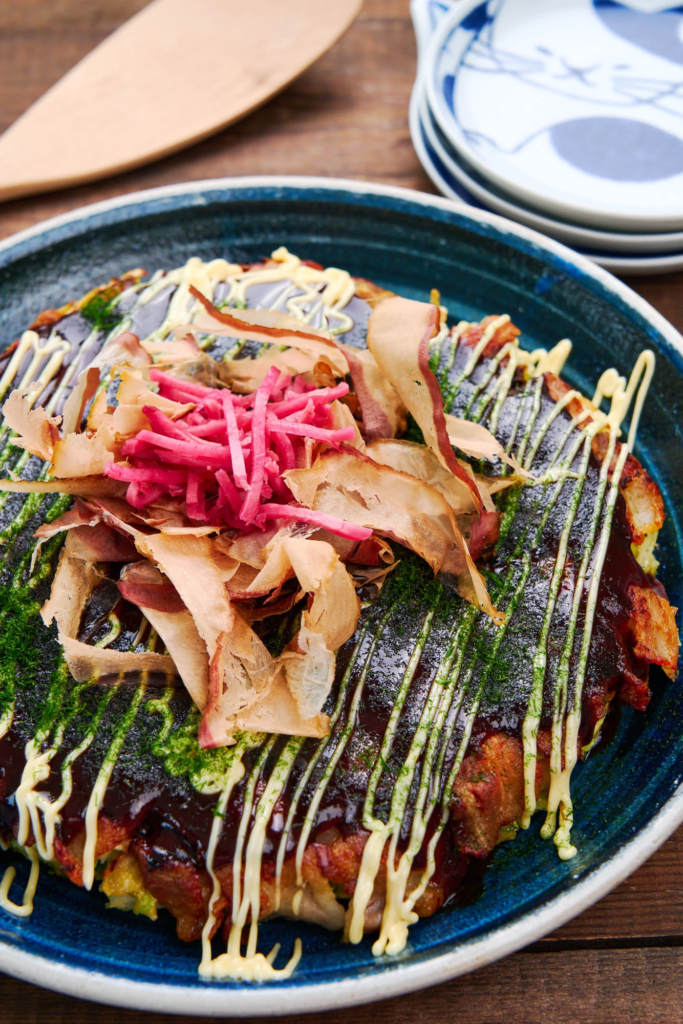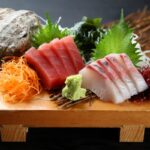Step into the world of Okonomiyaki – a cherished Japanese pancake adored for its fluffy texture and delectable flavours. This healthy Japanese food isn’t just a snack; it’s a culinary journey embodying Japanese comfort cuisine’s essence.
With its simple yet wholesome ingredients like shredded cabbage, savoury dashi, and flavorful toppings, Okonomiyaki offers a delightful balance of taste and nutrition.
Join us as we explore the art of making Okonomiyaki at home so you can savour this irresistible treat and experience the true essence of Japanese culinary tradition.
Let’s get started!
What is Okonomiyaki?
Okonomiyaki is a famous Japanese savoury pancake that originated in Osaka but is now enjoyed throughout Japan and beyond. “Okonomiyaki” translates to “grilled as you like it,” reflecting the dish’s versatility and customization options.
In Japan, Okonomiyaki is enjoyed as casual street food and a homemade meal. It’s often cooked and assembled right at the table on special tabletop griddles, allowing diners to tailor their Okonomiyaki to their liking.
Okonomiyaki has become a beloved dish in Japan and internationally with its comforting flavours and customizable nature.
Types of Okonomiyaki
Check out the variety of Okonomiyaki types, each offering a distinct take on the classic Japanese pancake. Here are some common types of Okonomiyaki:
Hiroshima-Style Okonomiyaki

Hiroshima-style Okonomiyaki is a unique variation of the traditional Japanese pancake originating in the Hiroshima region. Its distinct layering technique sets it apart, resulting in a multi-tiered pancake filled with various ingredients.
To create Hiroshima-style Okonomiyaki, each ingredient is cooked separately on a large griddle or skillet before being assembled into layers.
The result is a hearty and satisfying pancake that offers a delightful contrast of textures and flavours. The layers of ingredients come together harmoniously, creating a mouthwatering dish that is beloved by locals and visitors alike.
Osaka-Style Okonomiyaki

Osaka-style Okonomiyaki stands as the quintessential representation of this beloved Japanese pancake dish. Hailing from the bustling city of Osaka, this variation captures the essence of Okonomiyaki with its hearty ingredients and vibrant flavors
At its core, Osaka-style Okonomiyaki begins with a batter of flour, dashi (Japanese soup stock), eggs, and shredded cabbage.
However, what truly distinguishes this style is the integration of additional ingredients such as green onions, thinly sliced pork belly or seafood, and sometimes even tempura scraps or cheese.
Tokyo-Style Okonomiyaki

Tokyo-style Okonomiyaki differs from its counterparts with a thinner, crepe-like pancake base that highlights a delicate texture.
The batter is spread thinly on the griddle and filled with a generous amount of shredded cabbage and other ingredients. Toppings such as okonomi sauce, Japanese mayonnaise, bonito flakes, and aonori complete this savory delight, offering a unique spin on the classic Japanese pancake experience.
Okonomiyaki: Popular Japanese Street Food Ingredients
Here are the key ingredients you’ll need to make Okonomiyaki, a popular Japanese street food:
- Flour: Usually, all-purpose flour or a mixture of all-purpose flour and grated nagaimo (Japanese mountain yam).
- Cabbage: Finely shredded cabbage is a key ingredient and provides the bulk of the pancake.
- Eggs: These are used to bind the ingredients together and add richness.
- Water: Used to adjust the consistency of the batter.
- Dashi: A Japanese soup stock typically made from bonito flakes, kombu (dried kelp), or a combination of both. It adds umami flavor to the batter.
- Tenkasu (Tempura Scraps): Crispy bits of tempura batter add texture and flavor.
- Green Onions: Finely chopped for flavor and aroma.
- Toppings: Traditional toppings include okonomi sauce (a sweet and savory sauce similar to Worcestershire sauce), Japanese mayonnaise, aonori (dried seaweed flakes), and katsuobushi (bonito flakes).
Okonomiyaki Pancake Recipe: How To Make the Okonomiyaki at Home
Ingredients:
- 1 cup all-purpose flour
- 1 cup dashi (Japanese soup stock) or water
- 2 large eggs
- 2 cups shredded cabbage
- 2 green onions, finely chopped
- 1/4 cup tenkasu (tempura scraps) or chopped shrimp (optional)
- 1/4 cup grated nagaimo (Japanese mountain yam) or grated potato (optional)
- 4-6 slices thinly sliced pork belly or bacon (optional)
- Okonomi sauce (store-bought or homemade)
- Japanese mayonnaise
- Aonori (dried seaweed flakes)
- Katsuobushi (bonito flakes)
1. Prepare the Bater
a. In a large mixing bowl, combine the all-purpose flour and dashi (or water) to make the batter. Whisk until smooth.
b. Add the eggs to the batter and whisk until well combined.
c. If using grated nagaimo or potato, mix it into the batter until evenly distributed.
d. Stir in the shredded cabbage, chopped green onions, and tenkasu or chopped shrimp (if using) until everything is evenly coated with the batter.
2. Heat the Griddle or Skillet
- Heat a non-stick griddle or large skillet over medium heat. If using pork belly or bacon, lay the slices on the griddle or skillet and cook until slightly crispy. Remove from heat and set aside.
3. Cook the Okonomiyaki
a. Once the griddle or skillet is hot, lightly oil the surface.
b. Pour a portion of the batter onto the griddle or skillet to form a round pancake, about 1/2 to 3/4 inch thick.
c. Place a slice on the pancake batter if using pork belly or bacon.
d. Cook the Okonomiyaki for 4-5 minutes on each side or until golden brown and cooked through. Use a spatula to press down on the pancake to ensure even cooking gently.
4. Serve
a. Transfer the cooked Okonomiyaki to a serving plate.
b. Drizzle Okonomi sauce and Japanese mayonnaise over the top in a zigzag pattern.
c. Sprinkle with aonori and katsuobushi.
d. Optionally, add additional toppings such as pickled ginger or sliced green onions.
e. Slice the Okonomiyaki into wedges and serve immediately.
Enjoy your homemade Okonomiyaki, and as what the Japanese say before eating: Itadakimasu!
Conclusion
Okonomiyaki stands as a testament to the richness and versatility of Japanese cuisine, offering a delightful blend of flavors and textures in every bite.
Throughout this discussion, we’ve explored the art of crafting Okonomiyaki at home, from preparing the batter to selecting the perfect toppings.
Whether enjoyed as a casual street food snack or a comforting homemade meal, Okonomiyaki holds a special place in the hearts of food enthusiasts worldwide, inviting all to experience the joy of Japanese culinary tradition in the comfort of their own kitchen.
Frequently Asked Questions (FAQs)
What is okonomiyaki?
Okonomiyaki is a Japanese savory pancake that typically consists of a batter mixed with shredded cabbage and various toppings, such as sliced pork belly or seafood. It is cooked on a griddle and served with okonomiyaki sauce, mayonnaise, and other condiments.
How do you make okonomiyaki?
To make okonomiyaki, you first prepare the batter by mixing together ingredients like flour, dashi, and eggs. Then, add shredded cabbage and your choice of toppings before cooking the pancake on a griddle. Finally, drizzle okonomiyaki sauce and mayonnaise on top before serving.
What are the key ingredients in okonomiyaki?
The key ingredients in okonomiyaki include cabbage, pork belly, bonito flakes, okonomiyaki sauce, mayonnaise, worcestershire sauce, and toppings like shredded squid or yakisoba noodles.
Is okonomiyaki easy to make at home?
Yes, okonomiyaki is relatively easy to make at home once you have gathered the necessary ingredients. You can follow a simple okonomiyaki recipe to create this delicious Japanese dish in your kitchen.









